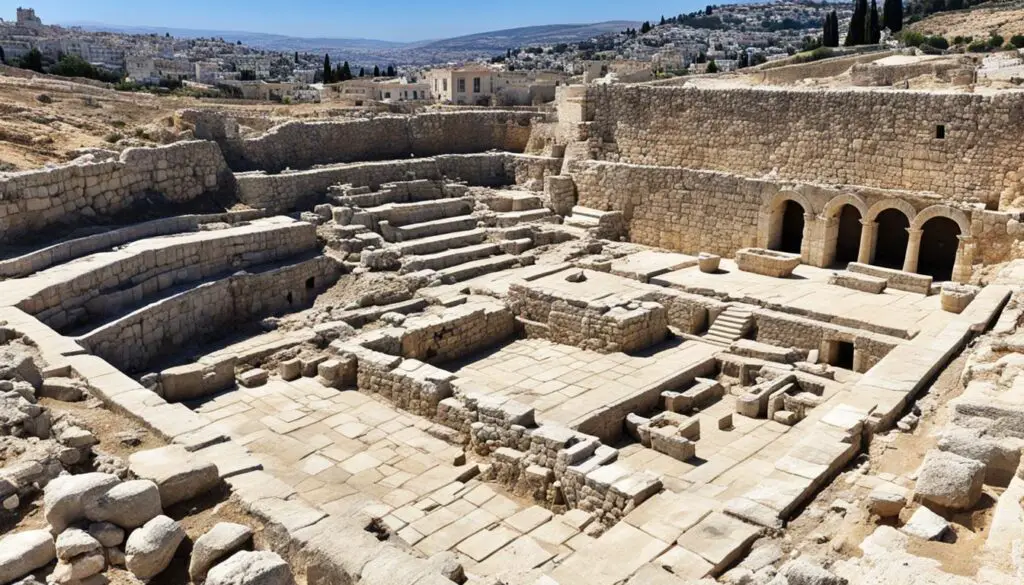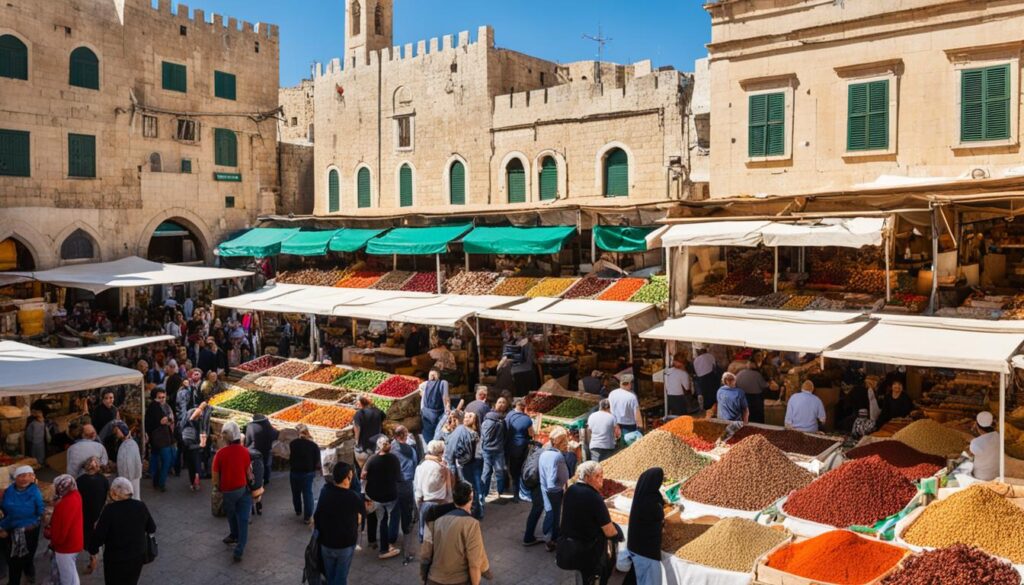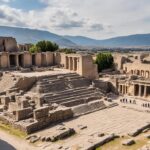Nazareth, a town steeped in biblical history, holds great significance within the New Testament scriptures. As the hometown of Jesus and the place where he spent his upbringing, Nazareth plays a central role in the biblical narrative. Understanding the historical background of Nazareth is crucial to comprehending the theological themes associated with this sacred location.
Throughout the Bible, Nazareth is mentioned multiple times, emphasizing its importance as a key location in the biblical accounts. Not only does it provide insights into Jesus’ formative years and upbringing, but it also serves as a backdrop for significant events and teachings during his ministry.
Archaeological excavations around Nazareth have unearthed historical artifacts, shedding light on the cultural and religious practices of the time. These discoveries help us connect with the material culture and daily life during Jesus’ time, deepening our understanding of the biblical context.
Nazareth is not only a historical location but also carries profound theological significance. The teachings and miracles performed by Jesus in Nazareth offer valuable insights into faith, humility, and the challenges he faced in his own community. Exploring the theological themes in Nazareth’s biblical context can enrich our understanding of the Christian faith.
Key Takeaways:
- Nazareth holds great historical and theological significance in the Bible, being central to Jesus’ upbringing and ministry.
- Archaeological discoveries in and around Nazareth provide insights into the cultural and religious practices of the time.
- Nazareth is referenced multiple times in the New Testament, highlighting its importance as a key location in biblical accounts.
- The teachings and miracles performed by Jesus in Nazareth have profound theological implications and offer valuable lessons in faith and humility.
- Exploring the historical, cultural, and spiritual aspects of Nazareth can deepen our understanding of the biblical narrative and our faith.
The Geographical Location of Nazareth
Nazareth, located in the northern region of Israel, holds a prominent place in biblical history. Situated in the Galilee region, specifically in the Lower Galilee, Nazareth’s geographical location is key to understanding its historical and cultural significance.
Being in close proximity to other significant biblical sites, such as the Sea of Galilee and Mount Precipice, further highlights its importance in the Bible. The northern region of Israel, where Nazareth is situated, played a crucial role in shaping the events and teachings of Jesus Christ.
Nazareth’s location in the Galilee region makes it a significant destination for visitors seeking to explore the rich biblical heritage of Israel.
Notable Biblical Sites in the Northern Region of Israel
| Biblical Site | Description |
|---|---|
| Sea of Galilee | A freshwater lake where Jesus performed multiple miracles, including walking on water and calming the storm. |
| Mount Precipice | A designated lookout point with stunning views over the Jezreel Valley, where Jesus faced rejection after proclaiming himself as the Messiah. |
| Tabor | A mountain where the Transfiguration of Jesus took place, witnessed by Peter, James, and John. |
Archaeological Discoveries in Nazareth
Archaeological excavations in Nazareth have unearthed a treasure trove of historical artifacts, shedding light on the ancient history of this significant town. These discoveries provide invaluable insights into the material culture and daily life during the time of Jesus, allowing us to connect more deeply with the biblical events that unfolded in Nazareth.
Among the remarkable archaeological findings in Nazareth are pottery shards dating back to the early Roman period. These fragments offer a glimpse into the pottery-making techniques and styles of the time, providing invaluable clues about the local craftsmanship and daily routines.

These archaeological discoveries not only enrich our understanding of Nazareth’s history but also help us to paint a vivid picture of life in this ancient town. Examining the intricate details of these artifacts brings the stories of the Bible to life, bridging the gap between the past and present.
One particularly remarkable find is a wine press carved from the bedrock. This discovery sheds light on the viticulture practices in Nazareth and highlights the importance of wine production in the region during that era. Such archaeological evidence gives us a deeper appreciation for the agricultural practices and economic activities that shaped the community of Nazareth.
Through the careful preservation of these archaeological remains, visitors to Nazareth can immerse themselves in the rich history and cultural heritage of the town. Exploring the excavation sites and witnessing the tangible remnants of the past allows us to forge a tangible connection with the biblical events that unfolded in Nazareth.
Theological Themes in Nazareth
Nazareth is more than just a historical location; it holds a profound spiritual significance in the biblical narrative. As the place where Jesus grew up and began his ministry, Nazareth is imbued with theological themes that resonate deeply with believers.
The teachings and miracles performed by Jesus in Nazareth carry profound theological implications. His words and actions in this sacred town reveal important truths about faith, humility, and the nature of God’s kingdom. Through his teachings, Jesus invites us to reflect on our own faith and to cultivate a humble and open-hearted disposition.
“Truly, I tell you, no prophet is accepted in his hometown.” – Luke 4:24
The rejection of Jesus by his own people in Nazareth serves as a powerful reminder of the tension between faith and familiarity. This rejection underscores the challenging nature of Jesus’ message and emphasizes the need for a receptive heart and a willingness to embrace new understandings of God’s truth.
Exploring these theological themes within the biblical context of Nazareth provides a unique opportunity to deepen our understanding of the Christian faith. By delving into the rich theological teachings rooted in Nazareth, we can cultivate a greater appreciation for the spiritual significance of this remarkable town.
Spiritual Lessons in Nazareth
Key biblical teachings in Nazareth include:
- The importance of faith, even in the face of skepticism
- The need for humility and openness to God’s revelation
- The transformative power of forgiveness and compassion
- The challenge of embracing God’s kingdom beyond religious and cultural boundaries
These teachings invite us to introspection and encourage us to embrace a closer relationship with God, guided by the example of Jesus’ ministry in Nazareth.
The Significance of Jesus’ Ministry in Nazareth
Jesus’ ministry in Nazareth holds immense spiritual importance. It symbolizes the integration of divinity and humanity, as Jesus, the Son of God, lived among ordinary people in this humble town.
The miracles performed by Jesus in Nazareth, such as healing the sick and raising the dead, manifest his divine power and demonstrate God’s presence in the midst of everyday life. They serve as vivid reminders of God’s love and offer hope to those facing physical, emotional, or spiritual challenges.
The spiritual significance of Nazareth lies not only in its historical context but also in the timeless biblical teachings that continue to inspire and transform lives today. By immersing ourselves in the theological themes of Nazareth, we can deepen our faith, gain a richer understanding of God’s Word, and draw closer to the heart of Jesus.
Key Biblical Events in Nazareth
Nazareth played a pivotal role in several key biblical events that shaped the ministry of Jesus and his reception by the people. One notable event took place in the synagogue of Nazareth, where Jesus delivered a powerful message.
“The Spirit of the Lord is upon me because he has anointed me to proclaim good news to the poor. He has sent me to proclaim freedom for the prisoners and recovery of sight for the blind, to set the oppressed free.”
Jesus’ visit to the synagogue in Nazareth marked the beginning of his public ministry, where he revealed his divine purpose. By reading from the scroll of the prophet Isaiah, he proclaimed that the long-awaited Scriptures had been fulfilled in his coming. This event showcased Jesus’ authority and mission to bring salvation and liberation to the world.
However, instead of embracing their hometown prophet, the people of Nazareth rejected Jesus:
“Isn’t this Joseph’s son?”
“Surely you will quote this proverb to me: ‘Physician, heal yourself! Do here in your hometown what we have heard that you did in Capernaum.'”
Jesus’ rejection in Nazareth revealed the challenge he faced in being accepted by his own community. Despite witnessing his wisdom and miracles elsewhere, the people of Nazareth struggled to believe in him. This rejection foreshadowed the broader rejection of Jesus throughout his ministry.
Understanding these key biblical events in Nazareth helps us grasp the obstacles and opposition Jesus encountered during his earthly mission. It highlights the fulfillment of prophecies and underscores the significance of Jesus’ ministry in bringing salvation to all.
Key Biblical Events in Nazareth:
- Jesus’ proclamation in the synagogue of Nazareth (Luke 4:16-30)
- The rejection of Jesus by his hometown community (Luke 4:22-30)
Delve deeper into the biblical narrative with the insights gained from these key events, and discover the profound impact of Jesus’ ministry in Nazareth.

Continue reading to explore the fascinating cultural and religious practices of Nazareth in Section 6.
Cultural and Religious Practices in Nazareth
To fully grasp the biblical context, it is essential to explore the cultural and religious practices of Nazareth. Daily life in Nazareth during the time of Jesus included a variety of cultural practices and religious observances. These practices greatly influenced the customs and traditions of the community and are referenced in the Bible.
Agricultural practices played a significant role in the daily life of Nazareth. The people of Nazareth engaged in various farming activities, including cultivating crops such as olives, grapes, and grains. Shepherding was also a common occupation, and sheep and goats were crucial for both sustenance and trade within the community.
In addition to agriculture, traditional trades such as carpentry were prevalent in Nazareth. The town was known for its skilled carpenters, and this trade played a significant role in shaping the local economy and providing for the needs of the community.
The cultural and religious practices of Nazareth influenced the rhythm of daily life. The people observed religious rituals, festivals, and ceremonies according to Jewish traditions. The synagogue served as a central gathering place for the community, where religious teachings, prayers, and discussions took place. It was within this synagogue that Jesus himself delivered influential teachings and faced rejection from his own townspeople.
By gaining a deeper understanding of the cultural and religious backdrop of Nazareth, we can appreciate the context in which Jesus lived, the cultural values he encountered, and the impact he had on the community. It allows us to more fully comprehend the biblical narrative and draw valuable insights from the teachings and events that took place in Nazareth.

| Activities | Description |
|---|---|
| Agricultural Practices | Nazareth residents engaged in farming activities, cultivating crops like olives, grapes, and grains. Shepherding was also an essential occupation. |
| Traditional Trades | Carpentry was a prominent trade in Nazareth, with skilled carpenters contributing to the local economy. |
| Religious Observances | The people of Nazareth followed Jewish traditions, observing religious rituals, festivals, and ceremonies. The synagogue served as a central hub for community gatherings and religious teachings. |
Prophetic and Eschatological Significance of Nazareth
Nazareth holds a remarkable prophetic significance in the biblical narrative. The fulfillment of prophecies regarding Jesus Christ, such as being a descendant of David and being called a Nazarene, highlights the importance of Nazareth in God’s overarching plan of salvation.
One of the prophecies that find fulfillment in Nazareth is the messianic prophecy of Jesus being from the lineage of David. In Matthew 2:23, it is stated, “And he [Jesus] came and lived in a city called Nazareth, so that what was spoken by the prophets might be fulfilled, that he would be called a Nazarene.” This reference to Jesus being called a Nazarene echoes the prophecies found in the Old Testament, pointing to the prophetic significance of Nazareth.
“He shall be called a Nazarene.” – Matthew 2:23
In addition to the prophecies fulfilled in Nazareth, the rejection faced by Jesus in his hometown also carries eschatological significance. This rejection serves as a foreshadowing of future events and teachings related to the end times. Jesus himself referenced this prophetic significance when he said, “Truly, I say to you, no prophet is acceptable in his hometown” (Luke 4:24). This rejection in Nazareth prefigures the larger rejection of Jesus by the world and the fulfillment of end-time prophecies.
Exploring the prophetic and eschatological significance of Nazareth deepens our understanding of the biblical text and the unfolding of God’s redemptive plan. It reveals the intricate connections between the Old and New Testaments, showcasing the divine orchestration of prophecies and their fulfillment in the person of Jesus Christ.

By studying the prophetic significance of Nazareth, we gain a deeper appreciation for the intricate tapestry of biblical events and their wider theological implications. The town of Nazareth occupies a unique place in biblical history, serving as a testament to the faithfulness of God and the fulfillment of His promises. As we delve into the prophetic significance of Nazareth, we uncover a rich treasure trove of insights that illuminate the redemptive narrative woven throughout the scriptures.
Exploring Nazareth Today
Today, Nazareth remains a vibrant city that attracts visitors from all over the world. The city offers a range of tourist attractions, including the Basilica of the Annunciation, which marks the spot where the angel Gabriel appeared to the Virgin Mary.
The Nazareth Village provides a unique opportunity to step back in time and experience the daily life of Jesus’ time.
The lively markets, traditional cuisine, and picturesque landscapes make Nazareth a must-visit destination for those seeking to explore its rich history and cultural heritage.

Tourist Attractions in Nazareth
| Attraction | Description |
|---|---|
| Basilica of the Annunciation | A sacred site marking the spot where the angel Gabriel appeared to the Virgin Mary. The basilica features stunning architecture and religious artwork. |
| Nazareth Village | A living museum that recreates the daily life of Jesus’ time. Visitors can explore a reconstructed first-century village and participate in various activities. |
| Mary’s Well | A historic well believed to be the site where the Virgin Mary fetched water. It is a tranquil spot with cultural and religious significance. |
| Mount Precipice | A scenic overlook offering panoramic views of Nazareth and the surrounding countryside. It is mentioned in the Bible as the place where Jesus narrowly escaped a mob. |
| St. Joseph’s Church | A Roman Catholic church dedicated to St. Joseph, the earthly father of Jesus. It is known for its beautiful architecture and peaceful atmosphere. |
Conclusion
Nazareth, as the hometown of Jesus Christ, holds a significant place in the Bible. Exploring its historical significance, geographical location, archaeological discoveries, theological themes, key biblical events, cultural and religious practices, and prophetic and eschatological significance allows us to deepen our understanding of the biblical narrative and our faith.
Visiting Nazareth today provides a unique opportunity to connect with this ancient city and experience its rich historical, cultural, and spiritual heritage. From the Basilica of the Annunciation, marking the spot where the angel Gabriel appeared to the Virgin Mary, to the Nazareth Village, where you can step back in time and witness the daily life of Jesus, Nazareth offers a range of attractions that bring the biblical story to life.
Embark on an unforgettable journey to Nazareth and discover the depth of its biblical insights. Immerse yourself in the tangible history, explore the captivating archaeological discoveries, and gain a profound appreciation for the teachings and events that unfolded in this sacred place. Nazareth is a destination of both historical significance and spiritual significance, making it an essential stop for any seeker of biblical knowledge.







